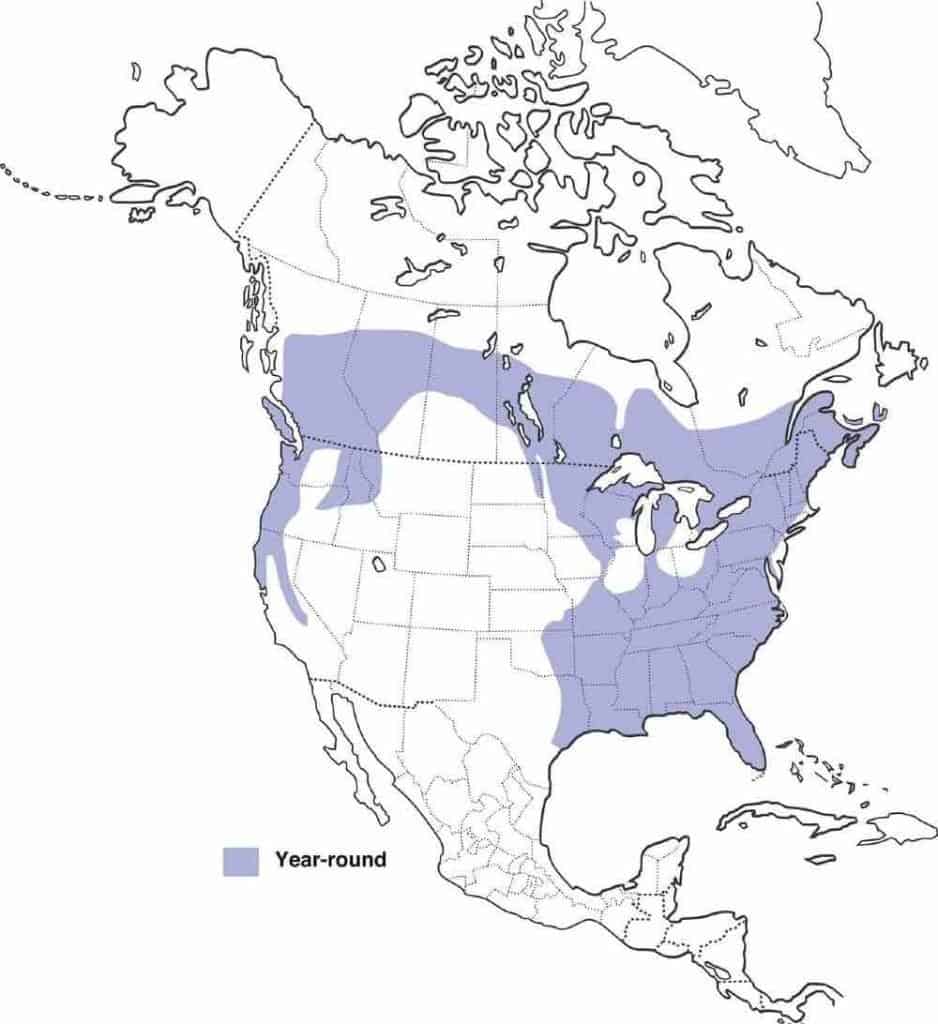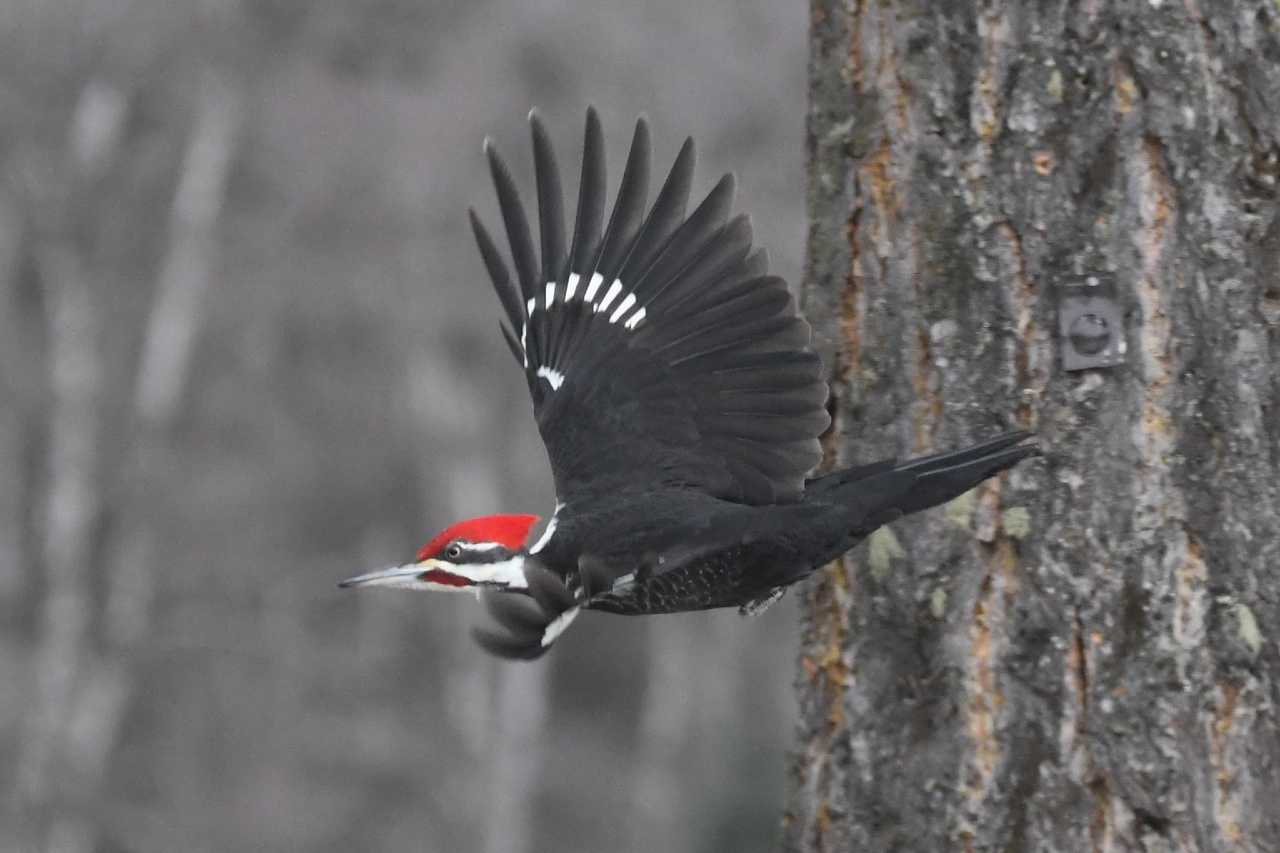Inside: The similarities and differences between the male vs female pileated woodpecker along with lots of videos and photos.
The pileated woodpecker is North America’s largest species of woodpecker. Its physical size, coloration, and other attributes make it one of the most unmistakable wild birds.
They’re year-round birds that live in Canada, the upper midwest, and eastern parts of the US. They are also found to a lesser extent in the pacific northwest.
They can be primarily found deep in the forests with large, dead trees. If you live in a wooded area within their range, you have a good chance of seeing them.

I’ve been backyard birding for more than 20 years. In that time I’ve only seen one pileated woodpecker. It was flying through a densely forested area I was hiking through and stopped me in my tracks. It was so HUGE!
Since then, I had to know everything I could about this unique bird so dove into the research. I hope you enjoy learning about North American’s largest woodpecker as much as I did.
Similarities with Male & Female Pileated Woodpecker
In a lot of ways, the male and female pileated woodpeckers are nearly the same. Specifically in their size and appearance.
Size
Both the male and female pileated woodpecker are the same size.
- From beak to tail, they measure 16-19.5” in length.
- They weigh between 8.8-16 ounces.
- They have a wingspan of 26-30”, while in flight.
For comparison, pileated woodpeckers are about the size of the common crow.
Appearance
Both the female and male have the same basic coloration.
- Black body
- Black bill
- Bright red triangular-shaped crest
- White stripes on the throat and neck
- A curved line of white feathers on the underside of their wings can be seen while they’re in flight.
Physical Attributes
Both the female and male have other similar physical attributes. And may I add – really fascinating attributes. Let’s explore.
Feet, Toes & Claws
On each of their feet, they both have two toes pointed forward and two pointed backward with long, sharp, curved claws at the ends. This is referred to as zygodactylous.
Their unique feet enable them to cling to the bark of trees as they forage for insects or chisel out holes for nesting and brooding.
Check out the feet, toes, and claws on this bad boy:
Beak
Both male & female pileated woodpeckers have long, tough beaks with a tip shaped like a chisel – ideal for all the pecking they do to drill into bark for insects and excavate holes for nesting. This beak is designed to withstand the bird hitting against trees up to 12,000 times a day! Pass the aspirin, please.
Head
The head of the pileated woodpeckers is extremely strong and hard.
Muscles and a section of spongy bone pad their thick skull to prevent injury to the brain, eyes, and ears from the extreme pounding.
Their neck is especially long and strong as its job is to thrust the bird’s head back and forth REALLY fast to essentially rip open the tree.
They both have short and thick feathers over their nostrils that prevent wood chips from flying up into their nose. Amazing!
Why do they hammer so much? Two reasons…
- They have a hearty appetite that is primarily satisfied with carpenter ants and beetle larvae – which live under the bark. Although they eat other foods as well, they prefer insects.
- Home sweet home is inside the cavity of a tree. Trees don’t grow with cavities so the pileated woodpeckers are obliged to drill them out.
Checkout a pileated woodpecker hammering away in action:
Tongue
OK, this just may blow your mind…the tongue.
Both male and females’ tongues are extremely long, sticky, contain barbs and a spear at the end! All of these features enable the bird to capture and draw out insects into its mouth.
In fact, the tongue is so long the bird’s unique anatomy provides space for it to wrap the tongue in and around the skull when not in use.
Here’s some pileated woodpecker tongue in action:
Eyes
I’ve often found the pileated woodpecker eyes to resemble marbles. Almost zombie-like.
The eyes rest on either side of the bird’s head, each with a large black dot in the center surrounded by yellow which seems to change shades from bright yellow to gold.
Tail Feathers
Both genders are equipped with long, thick tail feathers. This allows them to comfortably rest their large body against the tree as their search for food or drill holes.
Behavior
Behaviorally, male vs female pileated woodpeckers are nearly the same.
The one obvious exception is their sex organs which enable the male to fertilize the female and the female to lay eggs.
Both males and females share nest-building, incubating, and raising of the young.
Differences Between the Male & Female Pileated Woodpecker

Appearance
Although both males and females have the same basic coloration as described above, there are two differences between the genders and the easiest way to tell them apart. (1) the crest, and (2) the cheek.
Crest
The main difference is the crest. While both male and female crest is flaming red and triangle-shaped, the male’s crest is longer – goes all the way to its beak – whereas the female’s crest does not extend beyond the forecrown
Cheek
The other difference is the male has a red stripe on his cheek while the female’s cheek remains black. (Ornithologists refer to this area as the “mustache”).
This video shows the female (left) and male (right) together at a feeder. Pay close attention to their crests and checks.
Behavior
As mentioned earlier, the male vs female pileated woodpeckers exhibit nearly the same behaviors except the male has the ability to fertilize the female and the female is able to lay eggs but not vice versa.
What Next?
Check out the range map above to see if pileated woodpeckers live nearby. If so, see if you can find a wooded area with very tall and (ideally) dead trees. You just may come across a pair. If you have binoculars, see if you can notice the differentiation between the female and male.
Learn 5 Proven Ways to Attract Pileated Woodpeckers
Pin it to Pinterest for Later!






